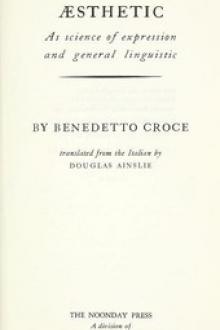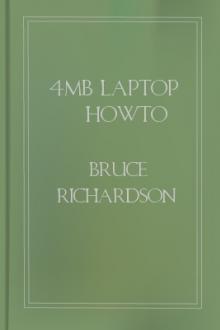Aesthetic as Science of Expression and General Linguistic, Benedetto Croce [read e books online free TXT] 📗

- Author: Benedetto Croce
- Performer: 1426434839
Book online «Aesthetic as Science of Expression and General Linguistic, Benedetto Croce [read e books online free TXT] 📗». Author Benedetto Croce
‘You are mightily mistaken; I am, on the contrary, a portmanteau, an exhibition by the painter of red, white, grey, and yellow tints.’”
Vischer also made fun of Zimmermann’s enthusiasm for the aesthetic value of the sense of touch. “What joy it must be to touch the back of the bust of Hercules in repose! To stroke the sinuous limbs of the Venus of Milo or of the Faun of Barberini must give a pleasure to the hand equal to that of the ear as it listens to the puissant fugues of Bach or to the suave melodies of Mozart.” Vischer defined the formal Aesthetic of Zimmermann as a queer mixture of mysticism and mathematic.
Lotze, in common with the great majority of thinkers, was dissatisfied with Zimmermann, but could only oppose his formalism with a variety of the old mystical Aesthetic. Who, he asked, could believe that the human form pleases only by its external proportions, regardless of the spirit within. Art, like beauty, should “enclose the world of values in the world of forms.” This struggle between the Aesthetic of the content and the Aesthetic of the form attained its greatest height in Germany between 1860 and 1870, with Zimmermann, Vischer, and Lotze as protagonists.
These writers were followed by J. Schmidt, who in 1875 ventured to say that both Lotze and Zimmermann had failed to see that the problem of Aesthetic concerned, not the beauty or ugliness of the content or of the form as mathematical relations, but their representation; K�stlin, who erected an immense artificial structure with the materials of his predecessors modified; Schasler, who is interesting as having converted the old Vischer to his thesis of the importance of the Ugly, as introducing modifications into the beautiful and being the principle of movement there. Vischer confesses that at one time he had followed the Hegelian method and believed that in the essence of beauty is born a disquietude, a fermentation, a struggle: the Idea conquers, hurls the image into the unlimited, and the Sublime is born; but the image, offended in its finitude, declares war upon the Idea, and the Comic appears. Thus the fight is finished and the Beautiful returns to itself, as the result of these struggles. But now, he says, Schasler has persuaded him that the Ugly is the leaven which is necessary to all the special forms of the Beautiful.
E. von Hartmann is in close relation with Schasler. His Aesthetic (1890) also makes great use of the Ugly. Since he insists upon appearance as a necessary characteristic of the beautiful, he considers himself justified in calling his theory concrete idealism. Hartmann considers himself in opposition to the formalism of Herbart, inasmuch as he insists upon the idea as an indispensable and determining element of beauty. Beauty, he says, is truth, but it is not historical truth, nor scientific nor reflective truth: it is metaphysical and ideal. “Beauty is the prophet of idealistic truth in an age without faith, hating Metaphysic, and acknowledging only realistic truth.” Aesthetic truth is without method and without control: it leaps at once from the subjective appearance to the essence of the ideal. But in compensation for this, it possesses the fascination of conviction, which immediate intuition alone possesses. The higher Philosophy rises, the less need has she of passing through the world of the senses and of science: she approaches ever more nearly to art. Thus Philosophy starts on the voyage to the ideal, like Baedeker’s traveller, “without too much baggage.” In the Beautiful is immanent logicity, the microcosmic idea, the unconscious. By means of the unconscious, the process of intellectual intuition takes place in it. The Beautiful is a mystery, because its root is in the Unconscious.
No philosopher has ever made so great a use of the Ugly as Hartmann. He divides Beauty into grades, of which the one below is ugly as compared with that above it. He begins with the mathematical, superior to the sensibly agreeable, which is unconscious. Thence to formal beauty of the second order, the dynamically agreeable, to formal beauty of the third order, the passive teleological; to this degree belong utensils, and language, which in Hartmann’s view is a dead thing, inspired with seeming life, only at the moment of use. Such things did the philosopher of the Unconscious dare to print in the country of a Humboldt during the lifetime of a Steinthal! He proceeds in his list of things beautiful, with formal beauty of the fourth degree, which is the active or living teleological, with the fifth, which is that of species. Finally he reaches concrete beauty, or the individual microcosm, the highest of all, because the individual idea is superior to the specific, and is beauty, no longer formal, but of content.
All these degrees of beauty are, as has been said, connected with one another by means of the ugly, and even in the highest degree, which has nothing superior to it, the ugly continues its office of beneficent titillation. The outcome of this ultimate phase is the famous theory of the Modifications of the Beautiful. None of these modifications can occur without a struggle, save the sublime and the graceful, which appear without conflict at the side of supreme beauty. Hartmann gives four instances: the solution is either immanent, logical, transcendental, or combined. The idyllic, the melancholy, the sad, the glad, the elegiac, are instances of the immanent solution; the comic in all its forms is the logical solution; the tragic is the transcendental solution; the combined form is found in the humorous, the tragi-comic.
When none of these solutions is possible, we have the ugly; and when an ugliness of content is expressed by a formal ugliness, we have the maximum of ugliness, the true aesthetic devil.
Hartmann is the last noteworthy representative of the German metaphysical school. His works are gigantic in size and appear formidable. But if one be not afraid of giants and venture to approach near, one finds nothing but a big Morgante, full of the most commonplace prejudices, quite easily killed with the bite of a crab!
During this period, Aesthetic had few representatives in other countries. The famous conference of the Academy of Moral and Political Sciences, held in Paris in 1857, gave to the world the “Science du Beau”
of L�v�que. No one is interested in it now, but it is amusing to note that L�v�que announced himself to be a disciple of Plato, and went on to attribute eight characteristics to the beautiful. These he discovered by closely examining the lily! No wonder he was crowned with laurels! He proved his wonderful theory by instancing a child playing with its mother, a symphony of Beethoven, and the life of Socrates! One of his colleagues, who could not resist making fun of his learned friend, remarked that he would be glad to know what part was played in the life of a philosopher by the normal vivacity of colour!
Thus German theory made no way in France, and England proved even more refractory.
J. Ruskin showed a poverty, an incoherence, and a lack of system in respect to Aesthetic, which puts him almost out of court. His was the very reverse of the philosophic temperament. His pages of brilliant prose contain his own dreams and caprices. They are the work of an artist and should be enjoyed as such, being without any value for philosophy. His theoretic faculty of the beautiful, which he held to be distinct alike from the intelligence and from feeling, is connected with his belief in beauty as a revelation of the divine intentions, “the seal which God sets upon his works.” Thus the natural beauty, which is perceived by the pure heart, when contemplating some object untouched by the hand of man, is far superior to the work of the artist. Ruskin was too little capable of analysis to understand the complicated psychologico-aesthetic process taking place within him, as he contemplated some streamlet, or the nest of some small bird.
At Naples flourished between 1861 and 1884 Antonio Tari, who kept himself in touch with the movement of German thought, and followed the German idealists in placing Aesthetic in a sort of middle kingdom, a temperate zone, between the glacial, inhabited by the Esquimaux of thought, and the torrid, dwelt in by the giants of action. He dethroned the Beautiful, and put Aesthetic in its place, for the Beautiful is but the first moment; the later ones are the Comic, the Humorous, and the Dramatic. His fertile imagination found metaphors and similes in everything: for instance, he called the goat the Devil, opposed to the lamb, Jesus. His remarks on men and women are full of quaint fancies. He granted to women grace, but not beauty, which resides in equilibrium.
This is proved by her falling down so easily when she walks; by her bow legs, which have to support her wide hips, made for gestation; by her narrow shoulders, and her opulent breast. She is therefore a creature altogether devoid of equilibrium!
I wish that it were possible to record more of the sayings of the excellent Tari, “the last joyous priest of an arbitrary Aesthetic, source of confusion.”
The ground lost to the German school of metaphysicians was occupied during the second half of the nineteenth century by the evolutionary and positivist metaphysicians, of whom Herbert Spencer is the most notable representative. The peculiarity of this school lies in repeating at second or third hand certain idealist views, deprived of the element of pure philosophy, given to them by a Schelling or a Hegel, and in substituting a quantity of minute facts and anecdotes, with a view to providing the positivist varnish. These theories are dear to vulgar minds, because they correspond to inveterate religious beliefs, and the lustre of the varnish explains the good fortune of Spencerian positivism in our time. Another notable trait of this school is its barbaric contempt for history, especially for the history of philosophy, and its consequent lack of all link with the series composed of the secular efforts of so many thinkers. Without this link, there can be no fruitful labour and no possibility of progress.
Spencer is colossal in his ignorance of all that has been written or thought on the subject of Aesthetic (to limit ourselves to this branch alone). He actually begins his work on the Philosophy of Style with these words: “No one, I believe, has ever produced a complete theory of the art of writing.” This in 1852! He begins his chapter on aesthetic feelings in the Principles of Psychology by admitting that he has heard of the observation made by a German author, whose name he forgets (Schiller!), on the connexion between art and play. Had Spencer’s remarks on Aesthetic been written in the eighteenth century, they might have occupied a humble place among the first rude attempts at aesthetic speculation, but appearing in the nineteenth century, they are without value, as the little of value they contain had been long said by others.
In his Principles of Psychology Spencer looks upon aesthetic feelings as arising from the discharge of the exuberant energy of the organism.
This he divides into degrees, and believes that we attain complete enjoyment when these degrees are all working satisfactorily each on its own plane, and when what is painful in excessive activity has been avoided. His degrees are sensation, sensation accompanied by representative elements, perception accompanied by more complex elements of representation, then emotion, and that state of consciousness which surpasses sensations and perceptions. But Spencer has no suspicion of what art really is. His





Comments (0)